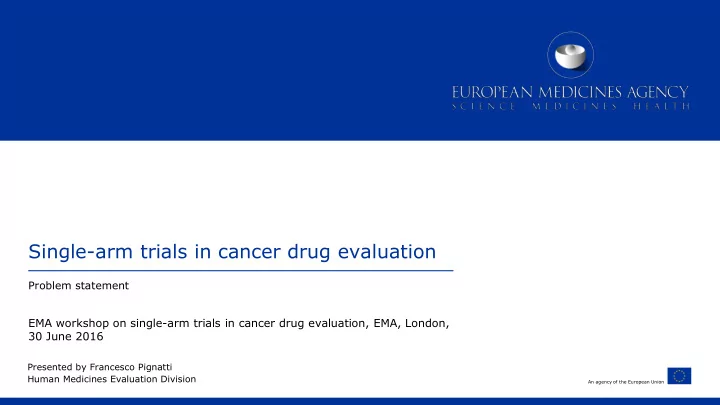

Single-arm trials in cancer drug evaluation Problem statement EMA workshop on single-arm trials in cancer drug evaluation, EMA, London, 30 June 2016 Presented by Francesco Pignatti Human Medicines Evaluation Division An agency of the European Union
Statement Randomised active and placebo-controlled trials are generally required; Most orphan drugs and paediatric indications submitted for regulatory approval are • based on randomised controlled trials that follow generally accepted rules and guidance. What if (adequately powered) randomised controlled trials are not feasible? “Single - arm trials” as the basis for approval… Population too small (rare cancer, stratified medicine,…)? • Compelling evidence of efficacy in (phase II) exploratory trials? • Current approach: case-by-case, often results-driven. Can we develop a more systematic approach? 1 Single-arm trials in cancer drug evaluation
“Dramatic effect” (ICH E10) Use of the external control design is restricted to situations in which the effect of treatment is dramatic and the usual course of the disease highly predictable; Start with externally controlled trial and switch to RCT (or stop) if effect not dramatic; What is the threshold for “dramatic”? Based on what parameter? Can we operationalise the concept? 2 Single-arm trials in cancer drug evaluation
Approaches to externally controlled trials (ICH E10) Detailed information (individual patient data regarding demographics, baseline status, concomitant therapy, and course on study); Should be as similar as possible to the population; use similar timing and methodology Selection of the control group before comparative analyses; Pre-specify matching on selection criteria and adjustments; Study group should be substantially superior to the most favourable control to conclude efficacy. Can we be more specific? 3 Single-arm trials in cancer drug evaluation
Early access v. complete information How does approval based on single-arm trials affect subsequent decisions? High unmet need, early (conditional) approval with high uncertainty are frequent in oncology; Need to communicate uncertainty to inform shared decision making • How to improve contribution to health technology assessment (HTA) • Early dissemination of results, early approval window of opportunity for RCTs reduced Single-arm trials may be the only acceptable option for some patients • 4
T he evolution of “ non-RCT evidence” Focus on opportunities Evidence can be based on a diverse family of data sources and • methodologies complementing (not replacing) RCTs. We now have a resource that was not available to the RCT pioneers • in the mid-20th century: rich data on past and current patients from observational studies and RCTs. We are now starting to develop the methodology and skill set to • make use to the resource – to overcome the “non -randomised stigma”? 5
Thank you Acknowledgements: Lucia Caporuscio • Corinne De Vries • Begona Delgado-Charro • Hans-Georg Eichler • Jorge Martinalbo • For information: www.ema.europa.eu info@ema.europa.eu 6
Recommend
More recommend